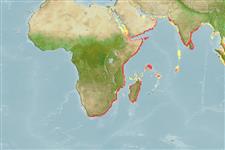>
Eupercaria/misc (Various families in series Eupercaria) >
Haemulidae (Grunts) > Haemulinae
Etymology: Pomadasys: Greek, poma, -atos = cover, operculum + Greek, dasys = with hair (Ref. 45335).
More on author: Day.
Environment: milieu / climate zone / depth range / distribution range
Ökologie
seewasser; brackwasser riff-verbunden; tiefenbereich 1 - 50 m (Ref. 97537). Tropical; 26°N - 35°S, 14°E - 101°E
Southeast Atlantic: north of Swakopmund, Namibia (Ref. 11228). Indian Ocean: east coast of Africa and Madagascar to Arabia, India and the Malay Peninsula.
Length at first maturity / Size / Gewicht / Alter
Maturity: Lm 15.0 range ? - ? cm
Max length : 55.0 cm TL Männchen/unbestimmt; (Ref. 2135)
Rückenflossenstacheln (insgesamt): 12; Rückenflossenweichstrahlen (insgesamt): 15-17; Afterflossenstacheln 3; Afterflossenweichstrahlen: 11 - 13. Silver to greenish, darker above; dark blotch on upper opercle; young with yellowish fins, older specimens dusky (Ref. 2799).
Inhabits coastal waters (Ref. 5213). Plentiful in tidal estuaries (Ref. 2135). Stomach contents of specimens collected from Iraq composed mainly of mollusks, sponges and tunicates (Ref. 97537). Large shoals of juveniles occur around shallow water reefs where they consume shrimps and other small invertebrates, being themselves eaten by larger fish; larger specimens are found in deeper water where they spawn throughout the year. Used extensively for bait, flesh rather insipid (Ref. 2799).
Oviparous, distinct pairing during breeding (Ref. 205).
Roux, C., 1986. Pomadasyidae. p. 327-330. In J. Daget, J.-P. Gosse and D.F.E. Thys van den Audenaerde (eds.) Check-list of the freshwater fishes of Africa (CLOFFA). ISNB, Brussels; MRAC, Tervuren; and ORSTOM, Paris. Vol. 2. (Ref. 2135)
IUCN Rote Liste Status (Ref. 130435)
Bedrohung für Menschen
Harmless
Nutzung durch Menschen
Fischereien: kommerziell; Köder: usually
Mehr Information
ReferenzenAquakulturAquakultur ProfilZuchtlinienGenetikElectrophoresesVererbbarkeitKrankheitenVerarbeitungNutrientsMass conversion
PartnerBilderStamps, Coins Misc.LauteCiguateraGeschwindigkeitSchwimmstilKiemenoberflächeOtolithsGehirngrößeSehfähigkeit
Tools
Zusatzinformationen
Download XML
Internet Quellen
Estimates based on models
Preferred temperature (Ref.
123201): 23.8 - 28.6, mean 27 °C (based on 176 cells).
Phylogenetic diversity index (Ref.
82804): PD
50 = 0.5000 [Uniqueness, from 0.5 = low to 2.0 = high].
Bayesian length-weight: a=0.01479 (0.00745 - 0.02937), b=2.98 (2.82 - 3.14), in cm total length, based on LWR estimates for this species & Genus-body shape (Ref.
93245).
Trophic level (Ref.
69278): 2.6 ±0.14 se; based on food items.
Widerstandsfähigkeit (Ref.
120179): mittel, Verdopplung der Population dauert 1,4 - 4,4 Jahre. (Preliminary K or Fecundity.).
Fishing Vulnerability (Ref.
59153): Moderate vulnerability (42 of 100).
Nutrients (Ref.
124155): Calcium = 33.1 [12.5, 69.1] mg/100g; Iron = 0.554 [0.283, 0.974] mg/100g; Protein = 19.2 [17.3, 21.0] %; Omega3 = 0.122 [0.065, 0.205] g/100g; Selenium = 34.7 [19.0, 62.9] μg/100g; VitaminA = 57.7 [19.7, 167.1] μg/100g; Zinc = 1.54 [1.05, 2.26] mg/100g (wet weight);
